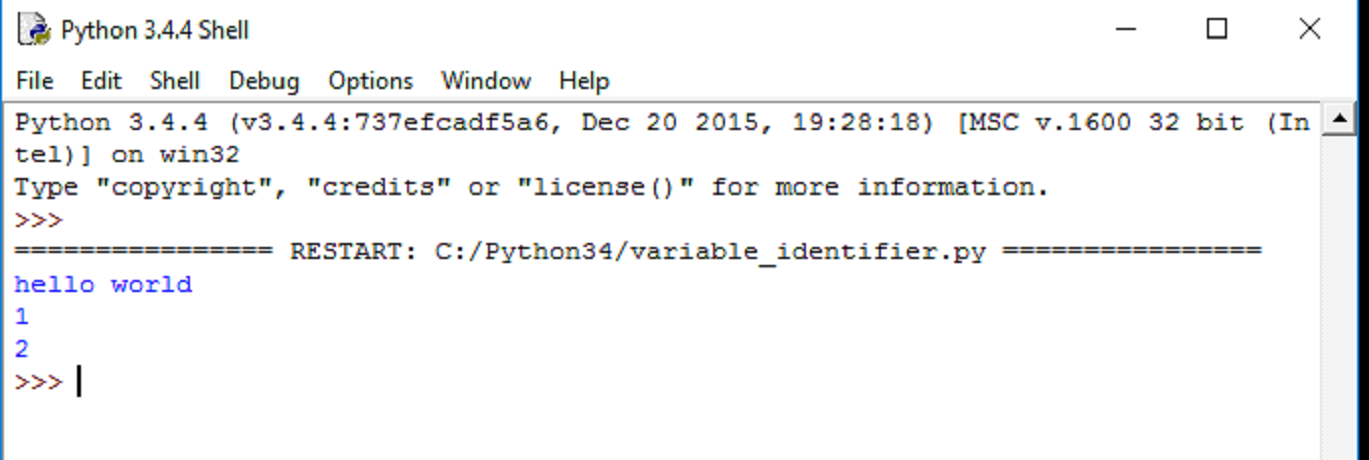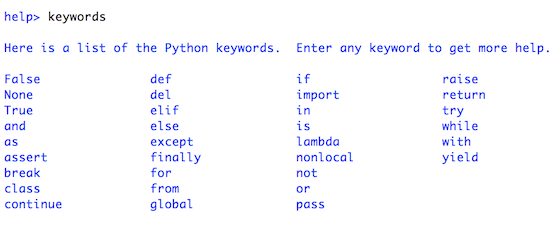자, 파이썬 키워드와 식별자에 대해 이야기해 봅시다. 최근에는 이 파이썬 튜토리얼에서 초보자를 위한 파이썬 설치와 설정에 대한 완전한 튜토리얼도 다루었습니다.
파이썬 키워드
간단하게 말해서, 파이썬 키워드는 예약된 단어입니다. 즉, 변수, 클래스 및 함수와 같은 개체의 이름으로 사용할 수 없습니다.
그래서 이 키워드들이 무엇인지 궁금할 것입니다. 이들은 파이썬 언어의 구문과 구조를 정의하기 위한 것입니다.
이 튜토리얼을 작성할 당시에는 파이썬 프로그래밍 언어에 33개의 키워드가 있음을 알아야 합니다. 그 수는 시간이 지남에 따라 변할 수 있습니다. 또한 파이썬의 키워드는 대소문자를 구분합니다. 그래서 그대로 작성되어야 합니다. 여기 파이썬 프로그래밍의 모든 키워드 목록이 있습니다.
모든 키워드를 보고 한 번에 모두 이해하려고 하면 압도될 것입니다. 그래서 지금은 그냥 이것들이 키워드라는 것을 알아두세요. 각각의 사용법을 배워갈 것입니다. 파이썬 셸 도움말을 통해 파이썬 키워드 목록을 얻을 수 있습니다.
모든 파이썬 키워드 목록
| and | Logical operator |
| as | Alias |
| assert | For debugging |
| break | Break out of Python loops |
| class | Used for defining Classes in Python |
| continue | Keyword used to continue with the Python loop by skipping the existing |
| def | Keyword used for defining a function |
| del | Used for deleting objects in Python |
| elif | Part of the if-elif-else conditional statement in Python |
| else | Same as above |
| except | A Python keyword used to catch exceptions |
| FALSE | Boolean value |
| finally | This keyword is used to run a code snippet when no exceptions occur |
| for | Define a Python for loop |
| from | Used when you need to import only a specific section of a module |
| global | Specify a variable scope as global |
| if | Used for defining an “if” condition |
| import | Python keyword used to import modules |
| in | Checks if specified values are present in an iterable object |
| is | This keyword is used to test for equality. |
| lambda | Create anonymous functions |
| None | The None keyword represents a Null value in PYthon |
| nonlocal | Declare a variable with non-local scope |
| not | Logical operator to negate a condition |
| or | A logical operator used when either one of the conditions needs to be true |
| pass | This Python keyword passes and lets the function continue further |
| raise | Raises an exception when called with the specified value |
| return | Exits a running function and returns the value specified |
| TRUE | Boolean value |
| try | Part of the try…except statement |
| while | Used for defining a Python while loop |
| with | Creates a block to make exception handling and file operations easy |
| yield | Ends a function and returns a generator object |
아래는 파이썬 프로그램에서 if-else 사용 예제를 보여주는 간단한 예입니다.
var = 1;
if(var==1):
print("odd")
else:
print("even")
위의 프로그램을 실행하면 파이썬은 고정된 키워드와 구문으로 if-else 블록을 이해하고 추가 처리를 수행합니다.
파이썬 식별자란 무엇인가요?
파이썬 식별자는 변수, 함수, 클래스, 모듈 또는 다른 객체를 식별하는 데 사용하는 이름입니다. 즉, 엔터티에 이름을 부여하려고 할 때 식별자라고 합니다.
가끔 변수와 식별자가 종종 동일하게 오해되지만, 그렇지 않습니다. 명확성을 위해 변수가 무엇인지 살펴보겠습니다.
파이썬에서 변수란 무엇인가요?
A variable, as the name indicates is something whose value is changeable over time. In fact a variable is a memory location where a value can be stored. Later we can retrieve the value to use. But for doing it we need to give a nickname to that memory location so that we can refer to it. That’s identifier, the nickname.
식별자 작성 규칙
식별자 작성을 위한 몇 가지 규칙이 있습니다. 그러나 먼저 파이썬이 대소문자를 구분한다는 것을 알아야 합니다. 즉, Name과 name은 파이썬에서 두 개의 다른 식별자입니다. 파이썬에서 식별자를 작성하는 데 적용되는 몇 가지 규칙이 있습니다.
- 식별자는 대문자와 소문자의 조합, 숫자 또는 밑줄(_)일 수 있습니다. 따라서 myVariable, variable_1, variable_for_print은 모두 유효한 파이썬 식별자입니다.
- 식별자는 숫자로 시작할 수 없습니다. 그래서 variable1은 유효하지만, 1variable은 유효하지 않습니다.
- !,#,@,%,$ 등 특수 기호는 식별자에 사용할 수 없습니다.
- 식별자의 길이는 어떤 길이든 될 수 있습니다.
이러한 것들은 식별자를 작성하기 위한 엄격한 규칙이지만, 따르는 것이 좋은 관행인 몇 가지 명명 규칙도 있습니다.
- 클래스 이름은 대문자로 시작합니다. 다른 모든 식별자는 소문자로 시작합니다.
- 단일 선행 밑줄로 식별자를 시작하면 해당 식별자가 비공개임을 나타냅니다.
- 식별자가 양쪽에 언더스코어로 시작하고 끝난다면, 해당 식별자는 언어에서 정의된 특수 이름입니다.
- c = 10은 유효하지만, count = 10을 작성하는 것이 더 의미가 있으며, 코드를 오랜 시간 후에 보더라도 그 역할을 쉽게 알 수 있습니다.
- 여러 단어는 밑줄을 사용하여 구분할 수 있습니다. 예를 들어 this_is_a_variable입니다.
다음은 파이썬 변수에 대한 샘플 프로그램입니다.
myVariable="hello world"
print(myVariable)
var1=1
print(var1)
var2=2
print(var2)
프로그램을 실행하면 출력은 아래 이미지와 같을 것입니다.

결론
그러니까, 오늘은 여기까지입니다. 다음 강의에서는 Python 문장과 주석에 대해 배우겠습니다. 그때까지 #happy_coding 🙂
Source:
https://www.digitalocean.com/community/tutorials/python-keywords-identifiers














